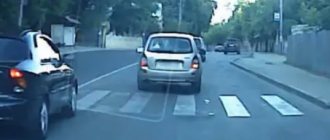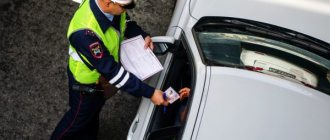Overtaking at a railway crossing is a gross traffic violation. This offense is punishable by a heavy fine or loss of your driver's license. Ignoring this point of the rules is due to the desire to cross the crossing as quickly as possible. At the same time, the driver forgets that this zone is a high-risk area.
Violation of this rule threatens an accident not so much for the locomotive moving on the rails, but to a greater extent for the driver and passengers of the vehicle itself. We should not forget that a collision between a vehicle and a moving train is fatal in most cases.
In what cases is overtaking allowed and when is it prohibited?
It should be noted that, in general, any crossing of the railway is allowed, in accordance with the requirements of paragraph 15.1 of the traffic rules, only at the crossing. A driver who crosses the rails outside the designated area will face a rather severe administrative penalty.
The very concept of overtaking is relevant for the most part when the road consists of two lanes for automobile traffic: one for each direction. When there are more of them, it is possible to get ahead of the curve, avoiding moving into the oncoming traffic.
Overtaking is a type of maneuver that involves entering the lane of traffic in the oncoming direction. The action is performed to get ahead of the moving car, it certainly ends with a return.
Advancement is movement without entering the lane of oncoming traffic at a speed greater than that of a passing vehicle (other vehicle).
According to the requirements of paragraph 11.4 of the traffic rules, overtaking moving vehicles at railway crossings or at a distance closer than 100 meters to it is prohibited: committing such an action will constitute an administrative offense for which a person will be punished. It is often committed by impatient drivers who want to “skip” the railway tracks as quickly as possible, subsequently paying a fine.
However, other situations may arise in this section of the canvas.
A detour is a maneuver performed in the presence of an obstacle, associated with entering the lane of oncoming traffic or into an adjacent oncoming lane, or without leaving the occupied lane.
If the road consists of two or more lanes for movement in each direction, at a railway crossing it formally becomes possible to get ahead of the car or go around an obstacle. However, it is extremely important to ensure that the road is adequately clear of oncoming traffic before leaving your lane, as you are in a high-risk area.
Not all road-railway intersections have a good viewing angle. It happens that the highway meets them in a sharp turn zone. In such a place it is better not to advance, since it is impossible to control the oncoming flow in conditions of insufficiently visible terrain.
Some drivers mistakenly think that on a road that has three lanes, it is allowed to detour and get ahead even on the tracks: after all, the middle one is intended for both directions of traffic. This is not true: it is considered to be both a passing and a counter vehicle at the same time, and you will also have to pay an administrative fine for traveling on it.
Another similar situation is the need to go around an obstacle that has arisen in front of the car.
An obstacle is a stationary foreign object or a faulty, damaged car, a serious defect in the road surface that makes it impossible to move in your lane.
It should be taken into account that vehicles that have stopped in accordance with the traffic rules, as well as the resulting traffic jam, are not considered obstacles.
For detours, the same rules apply as for ahead of vehicles on railway tracks. However, there is one caveat here. Paragraph 15.3 of the traffic rules states that the driver of a vehicle does not have the right to make a detour around vehicles standing in front of the rails, which involves driving into oncoming traffic. But it’s not the only thing that can get in the way of a car.
If traffic is impeded, for example, by a pile of debris, a fallen tree, or a destroyed part of the road surface, the presence of a broken marking line allows maneuvering. With prohibitory markings and the absence of other options, many drivers, in order to get to their destination, violate Part 1 of Article 12.16 of the Code of Administrative Offenses of the Russian Federation.
In this case, the traffic rules requirements have a gap, which is the subject of much debate. After all, it is strictly forbidden to cross marking 1.1 (single solid line) from any side. The choice remains with the person, but it should be remembered that the traffic police inspector who has identified an offense will certainly draw up an administrative protocol according to which a punishment will be imposed.
Need to know:
- The only option in a hopeless situation may be to film the traffic situation with a mobile phone camera.
- You can try to appeal the decision in court, then there is a possibility that it will be canceled and, on the basis of Article 2.9 of the Code of Administrative Offenses of the Russian Federation, the driver will be released from administrative liability due to the fact that the violation is insignificant.
In most cases, motorists drive along the same routes, that is, they know in advance that they will have to cross a railway crossing. Therefore, it is better to immediately prepare, assess the situation and try in any way not to violate the rules prescribed by law: they should always be a priority.
Important information
It should be understood that the legislation distinguishes between the concepts of detour and overtaking, so you need to understand what their differences are.
A detour involves the car going around a stationary car or an obstacle formed on the road.
But overtaking is a maneuver in which the vehicle ahead is advanced, at which the speed is greater than that of the vehicle being overtaken.
Both maneuvers can be performed either with or without entering the oncoming lane, so the difference is only in the static and dynamic nature of the overtaken object.
A railroad crossing has certain hazards that must be taken into account when driving in its area.
First of all, it should be understood that traffic at a crossing is organized in several ways, including traffic lights, railway employees, signs and barriers.
They allow you to control traffic, warning motorists in advance about the movement of the train and organizing movement in such a way as to avoid emergency situations.
Initial data
If a driver overtakes at a railway crossing and enters the oncoming lane, he will first of all create an emergency situation and may well drive onto the tracks, with the risk of hitting oncoming cars, which increases the chance of a collision.
The impossibility of overtaking and other maneuvers, as well as the presence of control devices, is indicated by road signs and markings; it is by following them that drivers must follow the rules and not commit offenses that could harm other road users and people’s health.
Usually at crossings, especially busy ones, there is a duty officer who services a specific intersection.
It is he who is responsible for driver control, traffic safety, and control of other systems.
The list of critical components includes crossing lighting, the operability of all train approach indication systems and the operation of the barrier, as well as compliance by drivers with travel rules and stopping the train at a safe distance, if necessary to prevent an emergency.
Classification of traffic violations at crossings
There are several main violations on railway passages. They are mainly associated with overtaking, driving through a prohibiting traffic light or duty signal, as well as going around a barrier.
In addition, even if the driver did not calculate the time and drove onto the rails without being sure of the completion of the maneuver, he will also be punished, since the traffic rules state that the maneuver must be started only with full confidence in its completion.
Other situations will be considered a violation and will result in a protocol being issued.
Overtaking occurs most often in conjunction with ignoring prohibiting traffic lights, and can lead to bad consequences.
After all, if you want to be on time, you may not notice the approaching train, stall at a crossing, or provoke an accident with another driver, and this will be a more serious violation.
Therefore, to avoid such behavior, inspectors often conduct raids in areas near crossings, imposing preventive fines on violators and explaining traffic rules.
Current regulatory framework
The functioning of railway crossings, the rules for their use by drivers and other aspects of operation are covered by traffic regulations, which are approved at the highest level.
It is specifically about crossings that is mentioned in Article 15, and paragraph one states that the car must give priority to the train, allowing it to pass in all situations.
Paragraphs 2 and 3 are devoted to the fact that the driver must be guided only by the requirements of the signs, and he is also prohibited from entering the crossing in situations where there is a clear prohibition, for example, when the barrier is lowered or the red lights at the traffic light.
Punishment for violating the rules of behavior on railway passages is prescribed in the Code of Administrative Offenses of the Russian Federation.
Its article 12.10 talks about all possible offenses that can be committed during a move.
Moreover, different clauses stipulate different measures of influence on drivers who have committed an offense, for example, this could be a fine, deprivation of a license, and for a long period.
But the final penalty depends on the circumstances, for example, if the violation was committed to save a human life or can be explained by other valid reasons.
Traffic on a controlled crossing
Such engineering structures include intersections of highways and railway tracks, equipped with special signaling devices that emit a loud sound when a train approaches on the rails. In addition, controlled crossings can be serviced by an employee on duty at JSC Russian Railways or another employee of the owner of tracks not intended for public use. There may be a barrier or special metal shields blocking the path.
The first information (warning) sign is placed 150-300 meters from the object outside the city limits, and 50-100 meters within the boundaries of the populated area. It can denote a crossing equipped with a barrier (1.1) and an object without it (1.2).
For the convenience of assessing the distance, the roadway is equipped with signs 1.4.1-1.4.6 (“Approaching a railway crossing”). They represent a white background on which inclined red stripes are applied: three, two or one. As you approach the structure, their number decreases. They help you navigate and determine in which zone the maneuvering ban begins to apply and where you need to reduce speed.
It is prohibited by law not only to overtake, but also to enter the controlled crossing itself:
- if the barrier or shield is lowered;
- if the traffic light gives a prohibition signal (even if the barrier is raised);
- when an employee gives a prohibitory sign using a red light, a bright flag or taking a pose with straight arms spread to the sides;
- when a traffic jam forms behind the crossing, which will not allow you to completely cross the rails.
In addition, the use of reverse gear is strictly prohibited within the facility.
Under no circumstances should you attempt to manually lift a barrier or metal shield. Drivers of slow-moving vehicles may cross railway tracks only with permission from the crossing worker.
The boundaries of the crossing area itself are indicated using signs 1.3.1 or 1.3.2. It is in the interval between the first and second sign that prohibitions apply directly to movement across railway tracks.
Fines provided for violations of traffic rules at railway crossings
According to Article 11, paragraph 4 of the Traffic Regulations, overtaking vehicles is prohibited if there are less than 100 meters left before the railway crossing. The amount of punishment is regulated by the Code of Administrative Offenses.
Here is what Article 12.15 of the Code of Administrative Offenses says about direct punishment for an unauthorized maneuver:
- Driving around an object while crossing the lane of oncoming traffic is punishable by a fine of 1000 – 1500 rubles;
- Overtaking an object at a railway crossing is punishable by a fine of 5,000 rubles, or a ban on driving a vehicle is imposed for a period of 4 to 6 months;
- Repeated violation of this clause of the rules entails deprivation of the driver's license for up to 1 year. However, if the violation is recorded by an automatic camera without the participation of an employee, the driver’s license cannot be taken away: in this case, representatives of the law will limit themselves to a fine of 5 thousand rubles.
If the driver decides to drive around a stationary object near the object discussed in the article, he will be subject to a financial penalty in the amount of 1000 to 1500 rubles. If the driver decides to drive around an object that is not included in the classification of obstacles, the liability will be higher - 5,000 rubles or confiscation of the driving license for a period of up to a year.
Traffic on an unregulated crossing
An object is considered such if there is no signaling equipment on it, and there is no maintenance by duty personnel or other employees who control the movement of cars across the rails. Unregulated railway crossings are also indicated by special warning signs (1.3.1, 1.3.2, 1.4.1-1.4.6). If they are not installed, crossing the paths is strictly prohibited.
Unregulated structures are usually equipped with:
- Marking 1.12 “Stop line”.
- Sign 2.5 prohibiting further movement without stopping.
The likelihood of safe passage to the other side of the railway track in such a place is determined by the driver himself, who is obliged to assess the situation.
Overtaking at an unregulated railway crossing is also strictly prohibited by the Traffic Rules. In accordance with the markings, it is allowed to get ahead of or go around the obstacle: there is no difference between the types of crossings.
You can begin moving towards the railway rails with the aim of crossing them only after the vehicle traveling in front has moved to the other side and has covered a distance from the tracks at least equal to the length of your car.
This rule is important to follow, since any vehicle can stall or suddenly stop directly behind the rails. As a result, the person following will be forced to brake right on the tracks. If there is an approaching train in the visibility zone, it is prohibited to drive beyond the stop line and cross. If it is absent, you should stop 10 or more meters before the nearest rail.
Overtaking before an unregulated crossing must be completed, as in the case of equipped objects, at least 100 meters before it.
Violations at railway crossings
Rules for crossing railway crossings are violated, most often, due to the desire to quickly cross it. However, such unjustified actions most often lead to emergency situations and tragic consequences.
The main types of violations at crossings are:
- Stop;
- Driving on a red signal or past a closed barrier;
- Detour of the car;
- Leading the vehicle;
- Overtaking.
Of all types of violations, overtaking is the most dangerous, since it involves driving into oncoming traffic, which can lead to serious consequences for a significant number of people.
Paragraph 11.4 of the traffic rules clearly states that overtaking vehicles is prohibited if the distance to the railway crossing is less than 100 meters. This distance is always marked with a special road sign, thanks to which the driver understands that overtaking in this zone is prohibited.
Overtaking before and after railway tracks
So, we have found out in what situations a complete ban is imposed on performing a maneuver. Now it’s worth figuring out when, being near the tracks, overtaking is possible, and what you need to know in order not to violate traffic rules.
As mentioned earlier, the maneuver is prohibited at a distance of less than 100 meters from the object. Of course, this line is not specifically marked on the roads. The driver here will only be helped by an eye sensor, as well as the location of sign 1.4.1 or 1.4.4 (three red stripes on a white background). If, while passing one of them, the driver has already started overtaking, it must be completed before the next one - 1.4.2 or 1.4.5 (two lanes).
Within a populated area, the prohibited “hundred-meter walk” begins immediately after sign 1.1 (1.2). Therefore, it is important to see it in advance.
Important to remember:
- If you notice the desired sign as you begin to perform the maneuver, it would be better not to complete it.
- To avoid violating the rules, you must slow down, let the overtaken vehicle move forward and return to your lane, taking a place behind it.
Formally, traffic regulations allow overtaking after a railroad crossing.
However, immediately after the tracks, in many places signs prohibiting maneuver are installed (3.20, 3.22), and speed limits are also introduced. This measure is advisable to ensure safety on such a risky section of the roadway. Therefore, you will have to wait to overtake until you pass a sign lifting the ban, or until the first intersection. Inside a populated area, in the absence of intersections, the ban is valid until leaving the countryside. It must be remembered that the effect of the sign does not end in the exit zone from the adjacent territory, as well as at the junction (intersection) of dirt roads that are not marked in accordance with the traffic rules.
What does the traffic regulations say?
Such a maneuver as overtaking is highlighted in paragraph 11.4 in the traffic rules. It clearly indicates all areas where overtaking is prohibited. These include railway crossings. In addition to the fact that you cannot overtake directly at a crossing, such a maneuver is prohibited 100 meters before it.
At railway crossings it is prohibited:
- stopping and parking;
- moving backwards;
- overtaking and detour;
- turn;
- movement to a prohibiting semaphore signal, etc.
IMPORTANT! Crossing railway tracks is permitted only at an equipped crossing (clause 15.1 of the traffic rules).
What conclusions can be drawn on the topic?
From all of the above, it is logical to draw the following conclusions: if a driver drives around an obstacle near a crossing and enters the oncoming lane, he will be subject to a fine, the maximum amount of which is 1,500 rubles. If there is no obstacle, but the driver desires to go around/overtake vehicles ahead, he risks losing his right to drive the car for a period of 4-6 months. If it turns out that the driver has been detained for such an offense more than once, the period of deprivation of license will be increased to a year.
Agree, the consequences of a banal reluctance to wait for your turn to cross the railway tracks are not very pleasant. Before attempting a prohibited maneuver, think about the consequences several times.
0
1
0
1
0
1
General points
Dear readers! The article talks about typical ways to resolve legal issues, but each case is individual. If you want to find out how to solve your particular problem , contact a consultant:
+7 (499) 938-81-90 (Moscow)
+7 (812) 467-32-77 (Saint Petersburg)
8 (800) 301-79-36 (Regions)
APPLICATIONS AND CALLS ARE ACCEPTED 24/7 and 7 days a week.
It's fast and FREE !
According to Russian legislation, overtaking at a crossing without a barrier is prohibited. You can perform the maneuver only if several conditions are met, and without driving onto the railway rails.
For violating the rules of overtaking and driving in the area of railway tracks, fines are imposed. In the event of a repeated offense, the fine is doubled and possible deprivation of the driver's license.
The traffic police inspector may not stop the car, but a report will be drawn up, and after some time the driver must pay a fine. Photo and video recordings are used as evidence of guilt.
According to traffic rules, overtaking at a crossing is strictly prohibited. The following nuances must be taken into account:
- You cannot maneuver into oncoming traffic. However, if the roadway is wide enough and the maneuver can be performed without entering the adjacent lane in front of the railway crossing, and also without running over the rails, then the maneuver is not considered a violation.
- It is prohibited to overtake any vehicles that are parked directly in front of a railway crossing.
The boundaries of railway crossings are indicated in Russia by signs No. 1.3.1 and 1.3.2.
Photo: railway road signs 1.3.1 - 1.3.2
Initial data
In order not to commit an offense, the driver must clearly understand what is overtaking, and in what cases it is about ahead.
Overrunning is an increase in the speed at which a car is moving in order to exceed the speed of another car. Advancement can be accomplished without entering the oncoming lane.
Detour, overtaking is a maneuver to get ahead of other vehicles, entering the oncoming lane. This involves avoiding a fixed or moving obstacle on the road.
Russian drivers should pay special attention to the current traffic rules and comply with them, including when crossing a section of railway tracks.
This is necessary primarily in order to preserve the health and life of the driver and passengers of the car.
The danger lies in the fact that many motorists try to reverse when they find themselves in the railway track area, and such a maneuver is strictly prohibited.
When approaching a crossing, you need to slow down and cross the tracks carefully and slowly.
What does the traffic rules say about distance?
You can start moving only when there is a permitting signal from a traffic light installed near the railway tracks. On driveways without barriers, audible warning signals are also used.
Paragraph 11.4 of the traffic rules establishes restrictions that must be taken into account when overtaking in the railway area:
| It is prohibited to overtake any type of vehicle | Walking ahead at a distance closer than one hundred meters to the railway rail |
| Moving boundaries | They are indicated by the corresponding road signs - 1.3.1 and 1.3.2. Overtaking directly on a railway lane is strictly prohibited by Russian law. |
| In a populated area, overtaking is prohibited immediately after that place | Where is the sign numbered 1.1 or 1.2 installed? |
| Outside the boundaries of the locality | Signs that indicate the distance that must be covered before the start of a railway crossing have two or three red stripes. Character numbers – 1.4.2 or 1.4.5 |
A situation may arise when the driver begins to overtake, and only after that notices a prohibitory sign. In this case, the maneuver does not need to be completed.
In order to avoid an offense, you need to slow down and let another car pass, after which you should return to the passing part of the lane as quickly as possible and follow the previously overtaken vehicle.
What regulations governs
Legal acts regulating overtaking at railway crossings and establishing fines for drivers who violate the law:
- Decree of the President of the Russian Federation No. 711 – On ensuring road safety.
- Decree of the Government of the Russian Federation No. 1090 - SDA.
- Federal Law No. 195 – Code of Administrative Offenses of the Russian Federation – is a regulatory document on the basis of which administrative punishment is imposed on drivers.
- Federal Law No. 170 – Rules for technical inspection of vehicles.
- Federal Law No. 196 – On road safety.
Failure to comply with current traffic laws can result in the driver not only being subject to a large fine, but also depriving the driver of a driver’s license for a period of several months to several years.
Overtaking before and after a railway crossing
You can overtake immediately after crossing the railway tracks, provided that there are no prohibiting signs or markings there. But you cannot maneuver less than 100 meters before the crossing. This distance is due to the fact that the driver may not have time to complete overtaking, and visibility before the crossing may be limited.
Overtaking can only be done if you are completely confident that it will be completed without interfering with other vehicles: this is impossible near railway crossings.
How should a driver behave at a railway crossing?
Just so you know, overtaking before a railway crossing has many restrictions and warnings, because this area is characterized by increased danger. Remember, it is prohibited to travel if:
- the barrier is closed or begins to fall;
- the traffic light is red;
- those on duty are given a prohibiting signal in the form of a raised baton, a red lantern, a flag, or arms outstretched to the sides;
- there is a traffic jam at the crossing;
- A train is approaching the crossing within sight.
A driver can be punished for unauthorized opening of a barrier or passing other cars into the oncoming lane. The same applies to those operating slow-moving vehicles without the permission of the station manager.
Attention! If you make a forced stop at a crossing, you must immediately disembark all passengers and take measures aimed at clearing the railway tracks. At the same time, you need to sound a general alarm, and when a train appears on the horizon, you need to run towards it and signal to stop.










